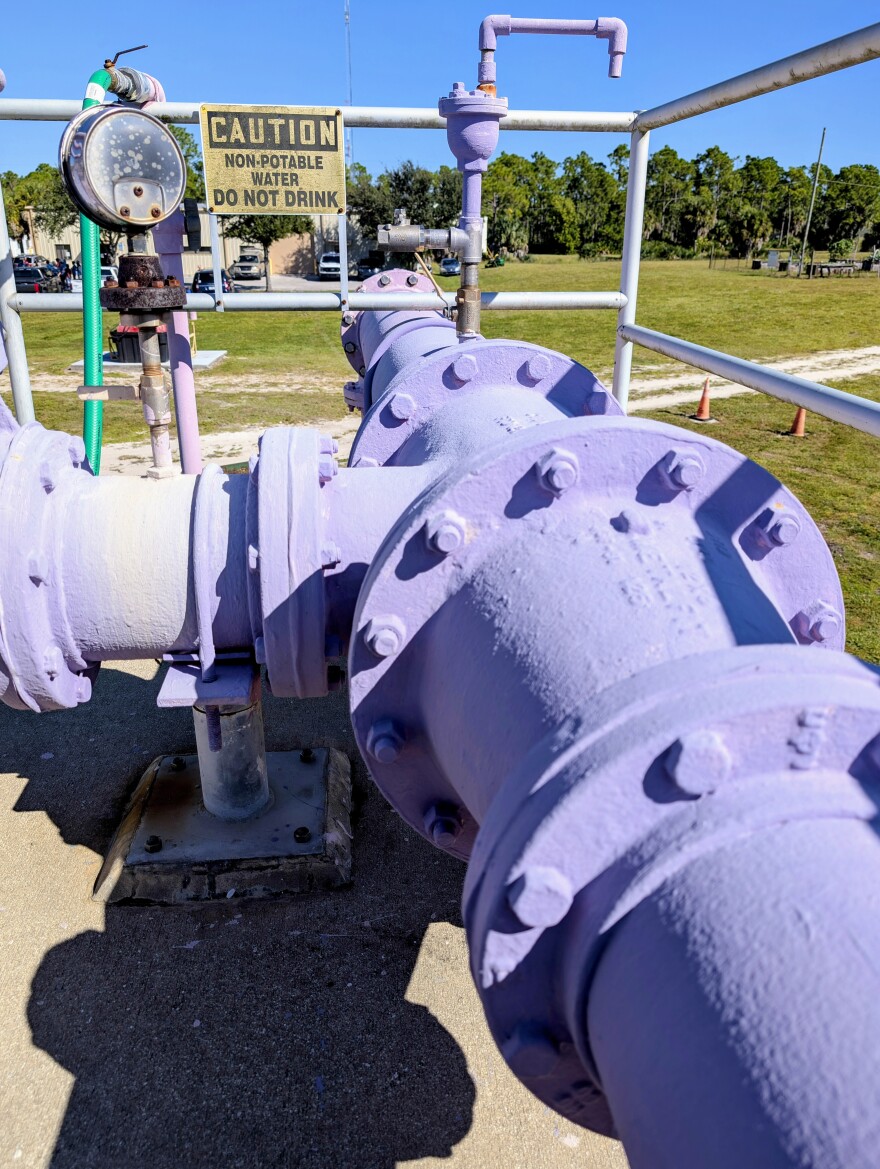More than 20 people got to see, and smell, the wastewater treatment process this week at Charlotte County's Burnt Store Water Treatment and Reclamation Facility, which offers free tours to the public on a regular basis so people have a more thorough understand of what happens there.
The process is finely tuned. There are a few key ratios of that to this, that if not right, can make a whole lot go wrong.
Other than that, most of the process of taking human urine, feces, and other bodily fluids and unmentionables out of the water is performed by bubbling air, microscopic creatures, a few chemicals, gravity, and the better part of a day.
That's sort of it.

There is a lot of stair-climbing during the tour of the plant, each time to reach the top of a tank with — y'know — in it.
The process starts at the headworks, which is the name for a large pipe containing everything flushed and drained by up to 15,000 people a day that empties into the first tank. Some of it's still recognizable. Screens separate out garbage and makes large and organic things smaller and organic things. It smells as would be expected.
In the second tank, or clarifier, lots of air is bubbled in breaking things up and providing oxygen to microscopic creatures that do what they do to make things disappear. Chemicals most have never heard of also react as the water moves along on the journey from brown-grey to yellow-clear.
In a third, round tank the sludge — yes, that stuff — sinks to the bottom ready to be drained out and hauled off.
The pleasant smell of a crisp fall morning returns.
There are special names for each tank, the infrastructure underwater, and for what certain things do. Scientific-sounding names: clarifiers, digestors, headworks. Or not: The beachhead. The kidney. Tank.
The true hero-employees of the plant — the human ones admit it — are the microscopic "bugs" that do the literal dirty work. The euglenoids, aspergillus, and corynebacterium and hundreds more — not every little helper is in every plant – but, combined, they do specific and integral things like eat something a human would never consider food.
The bacteria do the heavy lifting of decomposition, protozoa keep things balanced, fungi handle the tough stuff, and archaea finish the job.
More properly, it's a three-step process to turn raw wastewater into H2O clean enough to be used as reclaimed water. In each tank is a "treatment."
Primary treatment involves the screens to catch garbage, grit, and break down chunky things.
Secondary treatment is where that aeration happens and the microorganisms work to break down the organic matter.
The third treatment is where that sludge settles at the bottom and is hauled away. A form of chlorine disinfects the water, and some of the now-reclaimed water is sent out in those signature purple pipes to irrigate nearby parks, ball fields, and golf courses. The rest is injected into aquifers deep underground by an onsite well.
More advanced plants either built or retrofitted with additional ways to clean the water, which are rare in Southwest Florida, have sand filters, membrane filtration, or reverse osmosis systems to further purify the water. Someday, perhaps by a state deadline in 2032, raw wastewater going into a treatment plants will come out drinkable. It's already happening in places in Florida and California.
“It’s very neat, very clean, very organized. As an engineer I'm always interested in and seeing a neat, clean, efficient operation. And that's what they have here."Rick Daugherty, a Burnt Store Isles resident and a former retired mining and minerals processing engineer
Rick Daugherty, a Burnt Store Isles resident and a former retired mining and minerals processing engineer, was on the tour. He was impressed at the cleanliness of a place known for dealing with some gross stuff.
“It’s very neat, very clean, very organized,” he said. “As an engineer I'm always interested in and seeing a neat, clean, efficient operation. And that's what they have here."
The dates and times of the treatment plant tours change monthly. Click here to reserve a spot on a future tour.
The situation at the 40-year-old Burnt Store wastewater plant highlights challenges facing similar plants in rapidly growing areas in Florida.
Charlotte County commissioners initiated expansion plans at Burnt Store in March. The county approved $20 million to increase the facility's capacity to handle the area's rapidly growing population that's straining existing wastewater treatment infrastructure.
Recent polling shows water plant operators in Florida are a largely talented group of dedicated and competent people, but nearing retirement age and wondering who will want to take over the less-than-glamorous jobs, which pay poorly at first.
More residents push the plants to their capacity, but so does putting anything other than "The Three Ps" into the sink or toilet, requiring downtime to clean up a lot that shouldn't be there.
"The Three ’Ps" is wastewater plant operator humor for the trio of things only supposed to be flushed: one of the "p"s stand for “paper."
Eventually, all of the water will find its way into another freshwater source. It'll be ingested again and, these days, go down some sort of drain to return to a water treatment plant.
Environmental reporting for WGCU is funded in part by VoLo Foundation, a nonprofit with a mission to accelerate change and global impact by supporting science-based climate solutions, enhancing education, and improving health.
Sign up for WGCU's monthly environmental newsletter, the Green Flash, today.
WGCU is your trusted source for news and information in Southwest Florida. We are a nonprofit public service, and your support is more critical than ever. Keep public media strong and donate now. Thank you.








